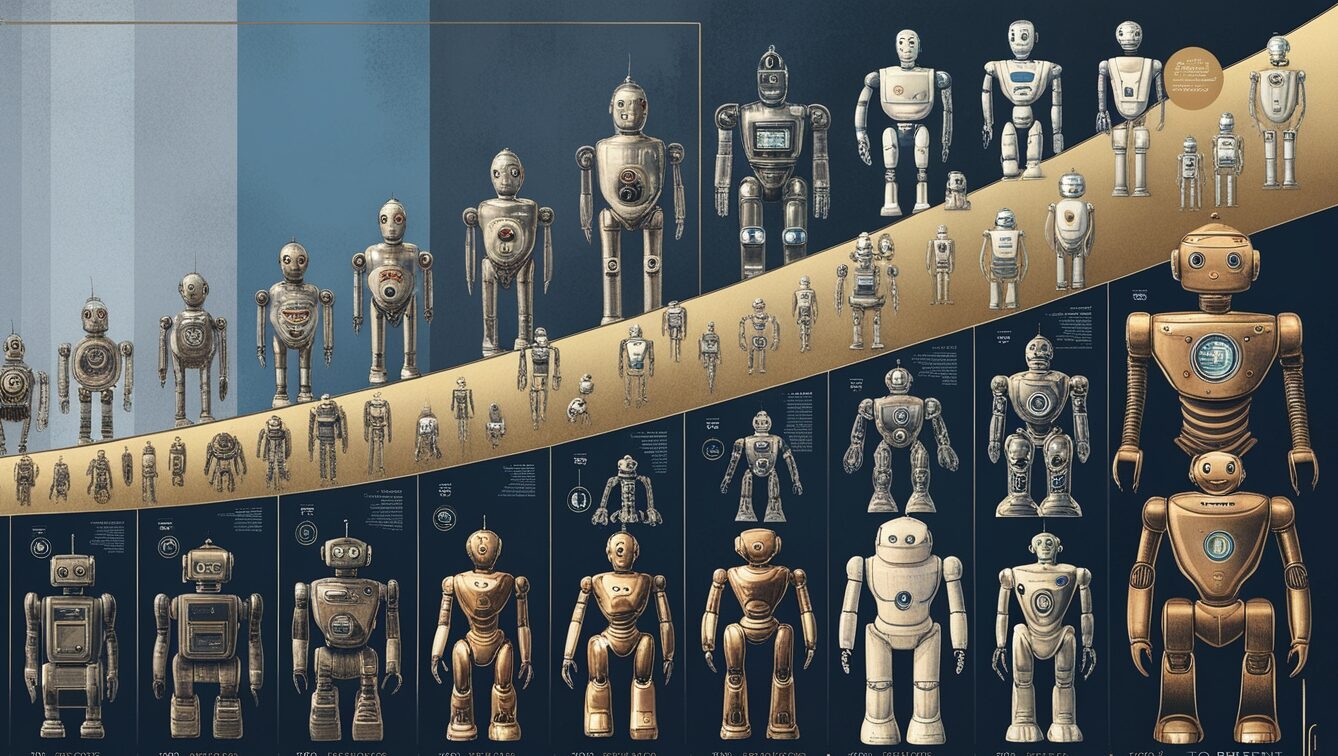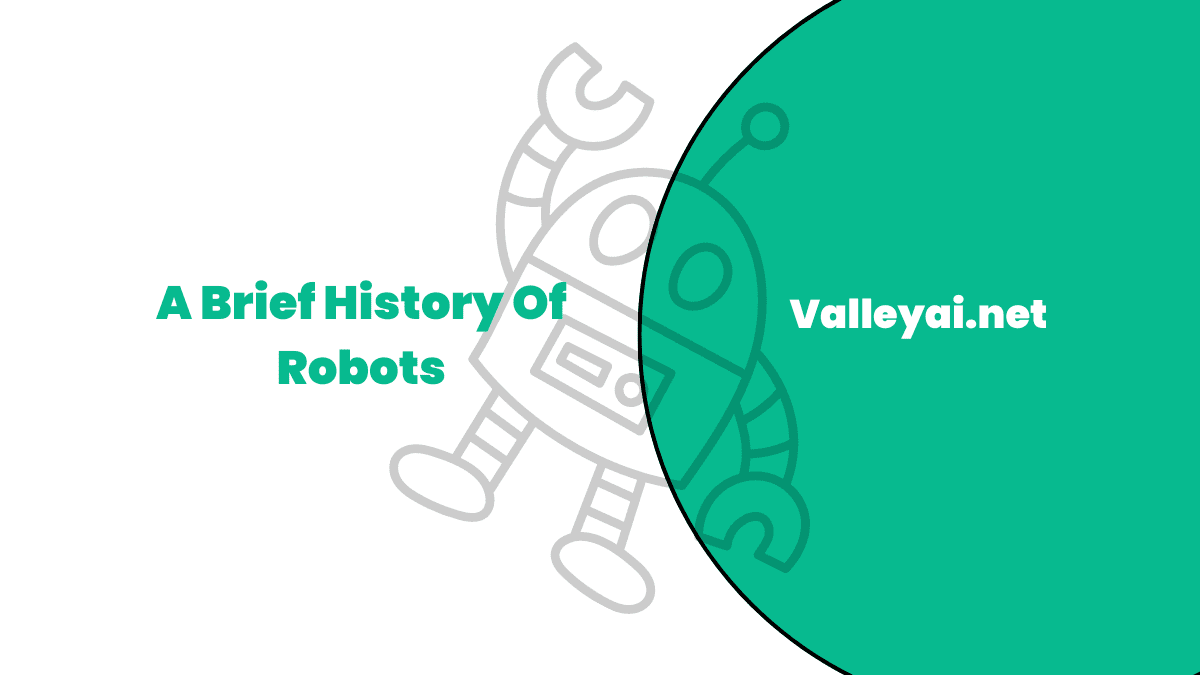Robotics has evolved through important moments up to the present day. We have been witnesses to the boom in the robotics sector over recent years. This surge, driven by disruptive technologies like 5G, augmented reality, Artificial Intelligence, and blockchain, provided a boost that changed the field.
From the origins of the first robots—built under diverse names and on different dates—the common goal has always been to prevent humans from performing the heaviest, dangerous, and tedious tasks. Today, autonomous and industrial mobile robotics assist large companies and SMEs by lowering production costs and increasing profitability, marking a significant point in robotics’ evolution.
Modern robots vary widely, from soft automatons to hard automatons and even nonmurderous automatons, often resembling toddlers who might fall over in ways that are oddly hilarious. These creations inspire a confusing mix of awe, admiration, and fear as they aim to make our lives easier and safer. We’re often terrified that they’ll supplant us, yet our trepidation hasn’t stopped the booming field of robotics from advancing.
Robots have grown smart and physically capable, leaving factories and labs to walk, roll, and even leap among us. In an age where automation is inevitable in capitalism, these machines are more likely to work alongside us than to replace us entirely. And, looking to the future, it may be that robots become friends rather than murderous foes.
Robots’ history is proving valuable for human advancement. Today, we’ll explore the brief history of robots and discuss how they’ve changed.
Origins of the Term “Robot” and “Robotics”
The term robot first appeared in 1921 in a play called R.U.R. (Rossum’s Universal Robots) by the Czech playwright Karl Capek. In the play, these mechanical men work on factory assembly lines and eventually rebel against their human masters. Interestingly, Capek derived the name from a Czech word meaning “slave,” emphasizing their role as workers created to serve their creators.
Since then, the idea of robots has expanded, featuring iconic examples like R2D2 and C3PO from Star Wars and even Rosie from the cartoon series The Jetsons, a human-like machine programmed for cooking and cleaning.
Our modern understanding of robots ranges from dangerous technological ventures that could someday outsmart humans, to helpful machines like the Rover Sojourner that explored the Martian landscape as part of the Mars Pathfinder mission. While some worry about robots outmuscling the human race and making us technology-dependent beings who passively let machines do all the work, others see them as invaluable in making life safer and more efficient across the world.
The word “robotics” was coined by Russian-born American science-fiction writer Isaac Asimov in 1942 in his short story “Runabout.” Unlike Capek’s earlier view, Asimov held a more positive opinion about robots’ role in human society, seeing them as helpful servants that he characterized as a better, cleaner race.
In his stories, he introduced the three Laws of Robotics, which laid the foundation for many sci-fi robotic characters. Law One insists a robot must not injure a human being or allow harm through inaction. Law Two requires it to obey orders given by human beings unless there is a conflict with the First Law.Law Three says a robot must protect its existence without violating the First or Second Law.
The Brief History Of Robots
The history of robots traces back to the ancient world, where inventors began creating machines with remarkable skills for their time. Around 3000 B.C., Egyptian water clocks featured human figurines that would strike hour bells to keep track of time. By 400 B.C., Greek mathematician Archytas of Tarentum designed a mechanical bird called The Pigeon, which could fly using steam power. These early mechanical devices laid the foundation for more ambitious inventions that would follow.
Centuries later, Leonardo da Vinci, the brilliant inventor and artist, crafted one of the first recorded designs of a humanoid robot in 1495. His detailed notebooks, rediscovered in the 1950s, included drawings of a mechanical knight in armour that could sit up, wave its arms, and even move its head and jaw. This ingenuity was matched in Hellenic Egypt by hydraulically operated statues capable of speaking, making gestures, and delivering prophecies—marking one of the earliest uses of mechanical devices for communication.
Moving into the 1700s, Jacques de Vaucanson introduced automata with impressive abilities. His most famous creations, crafted in 1737, included an automaton flute player, a tambourine player, and The Digesting Duck, which could imitate a real duck by flapping its wings, eating grain, and even defecating through a hidden compartment with over 400 parts. Such ingenious but sometimes impractical automata inspired future robotic designs, as inventors sought ways to refine these creations for practical use.
In the 19th century, Edison developed a talking doll, while Canadian innovators worked on a steam-powered robot. Yet, it was in the 20th century that scientific progress in the field of robotics truly surpassed earlier advancements. With a thousandfold increase in capabilities, robots evolved beyond mere complex mechanical toys like those of Japanese craftsman Hisashige Tanaka, also known as Japan’s Edison, who created devices that could serve tea, fire arrows from a quiver, and even paint Japanese kanji characters.
The First Modern Robots In History

Robots with human characteristics also gained attention in earlier times. For example, in 1810, Friedrich Kaufmann from Dresden, Germany displayed a soldier robot playing a trumpet. This robot was on display until April 30, 1950.
Later, in 1928, W. H. Richards showcased Eric at the Model Engineers Society annual exhibition in London. Eric had an aluminium suit of armour with eleven electromagnets, one motor, and a 12-volt power source that allowed him to move his hands and head through remote control or voice control.
In 1939, another remarkable humanoid robot named Elektro was showcased at the World’s Fair. Elektro stood 2.1 meters tall, weighed 120 kg, and could walk on voice command. He was able to speak up to 700 words using a 78-rpm record player and could even smoke cigarettes, blow up balloons, and move his head and arms. His steel gear cam and motor skeleton were encased in an aluminium skin.
The first electronic autonomous robots with complex behaviour were created by William Grey Walter of the Burden Neurological Institute in Bristol, England, during 1948 and 1949.
In the early 1950s, an inventor named George C. Devol from Louisville, Kentucky created a reprogrammable manipulator called Unimate. Based on Universal Automation, this invention marked the start of modern robotics. Devol obtained a patent for Unimate, but his early efforts to market it in the industry were unsuccessful until the 1960s.
At that time, businessman and engineer Joseph Engleberger acquired the robot patent. Engleberger modified Unimate into a reliable industrial robot, founded a company named Unimation to produce and market these robots, and earned the title Father of Robotics.
By the 1950s and 1960s, digitally operated and programmable robots set the stage for foundations in the modern robotics industry. In 1960, General Motors purchased the first Unimate, which was installed in 1961 at a Trenton, New Jersey plant to lift hot pieces of metal from a die-casting machine and stack them.
In 1969, Mechanical Engineering student Victor Scheinman created the Stanford Arm, a milestone in robotics as the first electronic computer-controlled robotic arm.
Meanwhile, academia made progress in the creation of new robots. In 1957, Charles Rosen joined Stanford Research Institute with a research team that developed Shakey from approximately 1966 to 1972 with Nils Nilsson and Peter Hart as project managers.
In 1970, Shakey emerged as a mobile robot capable of reasoning and navigating with the help of sensor inputs, including TV cameras, laser rangefinders, and bump sensors. It was an advanced robot that surpassed Unimate in functionality.
Shakey was designed for specialized industrial applications, and it could move on wheels around a room, observe its surroundings with television eyes, and even navigate unfamiliar surroundings. Shakey’s wobbly and clattering movements gave it a distinct personality, allowing it to partially respond to its environment.
In 1996, robotics saw a groundbreaking creation with the biomimetic robot known as RoboTuna. Built by doctoral student David Barrett at the Massachusetts Institute of Technology, RoboTuna was specifically designed to resemble a bluefin tuna. It could float in water and mimic the way fish swim, helping researchers study aquatic motion. This unique approach inspired future designs for underwater robots.
Sony released AIBO in 1999, a robotic dog that could interact with humans. Its first models in Japan sold out in just 20 minutes, reflecting a growing demand for interactive robotic companions.
Shortly after, Honda introduced ASIMO in 2000, an advanced humanoid project that could run, walk, communicate, and even recognise faces, voices, and posture.
In 2002, iRobot released the Roomba, the world’s first widely successful robotic vacuum cleaner, making robots an everyday household presence. On October 25, 2017, at the Future Investment Summit in Riyadh, a robot named Sophia made history by receiving Saudi Arabian citizenship, becoming the first robot to achieve nationality status.
Evolution Of Industrial Robotics
The evolution of industrial robots has reshaped manufacturing over the decades, bringing machines that can reproduce human movements with the strength, precision, and speed of a machine. Unlike humanoid designs, industrial robots don’t mimic the shape of humans but aim to match specific behaviors needed for factory tasks.
Industrial robots lack humanoid forms but precisely mimic human movement and behavior. The first industrial robot was Unimate by the company of Unimation, Unimate hydraulic arms were sold to General Motors as lifters for heavy loads, and similar models were gradually adopted in some factories, primarily in the automotive industry. In 1958, researchers developed a more advanced robot called Shakey.
One early leap came in 1954 when Barrett Electronics Corporation introduced the first AGV (Autonomous Guided Vehicle), an electric vehicle that operated without a human driver. Through the 80s and 90s, these AGVs developed complex behaviors with the help of advanced technology, including precise sensors and lasers, making them invaluable in many industries.
In 1978, the Japanese automation researcher Hiroshi Makino designed the SCARA (Selective Compliance Assembly Robot Arm), a four-axis robotic arm created specifically for pick and place operations. The SCARA arm could pick up, swivel, and plop items down with remarkable precision in a smooth motion.
Though SCARA arms are less flexible and not as strong as six-axis arms, they are faster and highly efficient at inserting small electronic components, speeding up global manufacturing of products like computer chips and watches. These robots are still commonly used in manufacturing today, illustrating the ongoing impact of Makino’s breakthrough design.
Although the first industrial robot was invented in America in the ’80s and ’90s, it is still developing in some European and Asian nations, most specifically Sweden or Japan. You’ll probably remember that IBM’s Deep Blue defeated the chess world champion, Garry Kasparov, in a chess match.
Artificial Intelligence has brought rapid changes to industrial robotics, offering major advantages like increased accuracy and improved decision making in the industrial sector. Today’s AI applications are more valuable and profitable than early tech advances, such as winning chess games against Kasparov. With features like predictive maintenance to handle obstacles and adaptive automation, AI helps companies of any size move toward a smart factory model.
Companies like Robotnik play a crucial role, providing mobile robotics that accommodates specific needs and works hand-in-hand with changing demands. Even niche markets like the cannabis industry are seeing the application of automated robotics. The infused pre roll machine has emerged as a game-changer that streamline the production process, increasing efficiency and precision. They can efficiently grind, fill, and twist pre-rolls, ensuring a consistent and high-quality product.
Conclusion
Robots are used in several different industries, from the automotive industry to food and beverage to the manufacturing industry, to name just a few. Robots have even been used to explore outer space. It seems that their use will continue to increase. This is very exciting, as robots may become even more prevalent in the future.
FAQs: A Brief History Of Robots
When was the robot first used?
The words “robots” were first used in 1921 in a Czech drama, R. U.R. The play focuses on assembling artificial humans.
Which is the first robot in the world?
George Devol’s first digitally controlled robotic system was invented in 1954 and eventually named Unimate. In the end, it laid the foundation for today’s robot manufacturing technology.
Who started robotics?
In the early 1960s, businessman Joseph Engleberger purchased the Devol robot technology patent, was able to transform it into a robot, and formed the Unimation company to manufacture and sell the robots. Engleberger has become known as the father of robotic innovation.
What is the most famous robot?
Sophia (Roboter)
What was the first successful robot?
Unimates: In 1961, Unimates was the first human-machine robot and the first machine to operate with humans. Its founder, George Devol, named it Unimation out of Universal Automating, the idea that automated devices would do different types of jobs.
Were there robots in the past?
In the third and fourth centuries BC, Greek inventors like Ctesibius of Alexandria conceived compressed-air and hydraulic equipment. A machine that uses cams to convert rotation into linear rotation is designed for the robot. His robot statue stands or lies down and is often accompanied during processions.
Why was the first robot invented?
While the first robot is designed for moving material, Englerberger has regarding the product is of high importance to the manufacturing sector.
WHO country invented robot first?
The first computer robots able to perform complex behaviors were created from 1948 to 1949 by William Grey Walter from the Burden Neurological Institute in Bristol, England. This is the first electronic autonomous robot.
How is robotics evolving?
Molecular evolution robotics is a fully integrated approach to artificial intelligence that is created using Darwin’s natural selection principles. To optimize a robot’s behavior or its components, the design of a computer program must be adapted to a behavioural goal.
How is the evolution of robotics affected our world?
Currently, robots are capable of simple locomotion on the ground, in space, and water. They can recognize things and map new environments.
Admin
My name is Kaleem and i am a computer science graduate with 5+ years of experience in AI tools, tech, and web innovation. I founded ValleyAI.net to simplify AI, internet, and computer topics while curating high-quality tools from leading innovators. My clear, hands-on content is trusted by 5K+ monthly readers worldwide.

